Abstract
We study the effects of the time evolution of the matter-gravity coupling on the luminosity distance, showing it can provide a natural explanation to the apparent Hubble tension. The gravitational coupling evolution induces a modification of the Friedman equation with respect to the CDM model, which we study in both the Einstein and Jordan frame. We consider a phenomenological parametrization of the low redshift variation of the coupling in a narrow redshift shell, showing how it can affect the distance of the anchors used to calibrate supernovae (SNe), while higher redshift background observations are not affected. This effect is purely geometrical, and it is not related to any change of the intrinsic SNe physical properties. The effects of a time varying gravity coupling only manifest on sufficiently long time scales, such as in cosmological observations at different redshifts, and if ignored lead to apparent tensions in the values of cosmological parameters estimated with observations from different epochs of the Universe history.
1. Introduction
The standard cosmological model based on assuming general relativity and large scale homogeneity and isotropy has proved quite successful in explaining the Universe we observe. Nevertheless there is some increasing evidence that local [1] and high redshift [2] estimations of Hubble parameter are not consistent, although recent observations are significantly reducing the difference [3]. Several solutions to explain this tension have been proposed, for example in terms of early dark energy [4,5], or local inhomogeneities [6]. See [7,8,9] for a review of the vast literature on the subject. Many efforts have been focused on providing an early Universe explanation for this discrepancy, while in this paper we will consider a local solution of the tension.
We show that a late time variation of the matter-gravity coupling can have an important effect on the anchors used to calibrate SNe, and provide an explanation to the tension. We derive the modified Friedman equation both in the Jordan and Einstein frame, to clarify the relation between cosmological parameters in the two frames, and use the Jordan frame formulation for calculating observational effects, since it simplifies the calculation of the luminosity distance. The effect on SNe distance is negligible, since they are located at higher redshift, while the distance of the anchors is modified w.r.t. a model, inducing a difference between the local estimation of the Hubble constant, and the value obtained from higher redshift observations, which are not affected by the local variation of the gravity coupling. As an application, we consider a model with a local variation of the gravitational coupling around , and show how it can fit well the local estimation [1] and SNe data at the same time, with a value of the parameter compatible with higher redshift observations [2].
2. Varying Matter-Gravity Coupling
Effective field theory is a powerful theoretical approach to study the Universe using very general model independent symmetry principles. The most general Jordan frame EFT quadratic order action [10] for single-field models can be written schematically as
which in the Einstein frame corresponds to
where plays the role of effective Planck mass, and denote the metric respectively in the Einstein and Jordan frame, and the two frames are related by the conformal transformation , and we are using units in which . The term in Equation (2) indicates that in the Einstein frame matter is not minimally coupled to the metric, i.e., indices in the matter Lagrangian are contracted with , not just . We will discuss in more details the implications of non-minimal coupling in the next section.
Physical observables should be invariant under conformal transformations, which are just field redefinitions, but the components of the energy-momentum tensor are not invariant [11], and under a generic transformation they transform as . This implies that the field equations obtained by varying the action with respect to the metric in different frames will have different energy-stress tensors on the r.h.s., and in particular the Friedman equation obtained assuming a FRW background metric, will be different in the two frames. In the following we will denote with a subscript and quantities respectively in the Einstein and Jordan frame.
3. Equations of Motion in Jordan and Einstein Frame
In order to understand the effects of conformal transformations let us consider how the equations of motion of massive particle transform. The equation of motion for a massive particle minimally coupled to gravity is obtained from the action
where we are denoting with the proper time, and are the coordinates of the particle as a function of proper time. The above action is the natural covariant generalization of the classical mechanics kinetic energy, and its variation is equivalent [12] to that of the action
where denotes the infinitesimal distance, implying that massive particles move along curves minimizing the distance between space-time points, i.e., geodesics. The variation of the action implies the Lagrange equations, which are the geodesics equations
where denotes the Christoffel connection coefficients. After a conformal transformation the action takes the form
showing that matter is not minimally coupled to gravity in the new frame, while the Christoffel coefficients transform as [13]
Using the above transformations we can obtain the equation of motion (5) in terms of the metric
The right hand side of Equation (9) indicates that particles do not follow the geodesics corresponding to the metric , which is sometime interpreted as the effect of a fifth force [14]. In this paper we will define as Jordan frame the one in which matter is minimally coupled to gravity, in which particles propagate along geodesics, while in the Einstein frame, which according to the general notation introduced above corresponds to , particles do not follow geodesics. The Einstein and Jordan frame calculations of physical observables must agree, since conformal transformations have no physical effect, and correspond only to a field redefinition, but it can be useful, although not necessary, to compare the two equivalent formulations to understand the difference with respect to general relativity.
4. Jordan Frame Modified Friedman Equation
In the Jordan frame the variation of the action w.r.t. the metric gives the field equation
from which we obtain the modified Friedman equation
where denotes the Jordan frame Hubble parameter, and is the Jordan frame scale factor. From the null geodesics equation we get that the comoving distance is given by
and from the relation between and the redshift we can compute the luminosity distance in a flat Universe, giving the standard formula
5. Einstein Frame Modified Friedman Equation and Conservation Laws
Let us assume a flat FRW metric
The results that follow can be easily generalized to a curved universe, so we will just focus on the flat case. Assuming no interaction between fluids in the Jordan frame, since matter follows the Jordan frame metric geodesics, the energy momentum tensor is conserved in the Jordan frame [12]
where a dot denotes a derivative w.r.t. the Jordan frame time . For a FRW metric the conformal transformation corresponds to a scale factor redefinition
where is the Einstein frame scale factor, while the components of a tensor in the two frames are related [11] by
which for a perfect fluid imply
Substituting Equations (17) and (18) in Equation (16) we obtain
The modification of the continuity equation is due to the non minimal Einstein frame gravity coupling, and is the manifestation of the fifth force [14], or equivalently of the universal interaction of the scalar field with any other field.
For a perfect fluid minimally coupled to the Jordan frame metric the equation of state and the continuity equation imply the well known relation
In the Einstein frame we can obtain a similar relation by rewriting the modified continuity equation in terms of the scale factor
which gives the solution
Note that Equation (23) can be also obtained directly by combining Equations (17), (19) and (21).
The redshift is related to the scale factor in the two frames by [15]
which substituted in Equation (23) gives
in agreement with Equation (18).
In the Einstein frame the metric is
where . The first Friedman equation in the Einstein frame takes the form
where the Hubble parameter is defined in the Einstein frame as
and are the energy densities of the different fluids.
From Equations (25) and (27) we obtain the redshift space equation
where we have defined in the standard way the dimensionless density parameters
and factorized the common factor . As expected, Equation (29) reduces to the standard CDM form when , i.e., when matter is minimally coupled to the Einstein frame metric , but if the cosmological parameters and will differ from the CDM ones.
Note that the modified Friedman equation in Equation (29) could be obtained directly from Equations (19) and (27), but the above derivation based on obtaining from the Jordan frame conservation equation is useful to understand the physical origin of the redshift space Friedman equation modification, and to check and interpret it in terms of conservation laws in different frames. As previously mentioned, note that the Hubble parameter and the density parameters appearing in the Friedman equation are not the same in the two frames due to the conformal transformations of the energy-stress tensor components given in Equation (19) and the difference between and , while physical observables such as the luminosity distance are conformally invariant [16,17,18].
Assuming isotropy, photons propagate along null geodesics defined by , implying , from which we obtain the standard flat FRW formula
6. Model
Let’s consider a model with a cosmological constant in the Jordan frame, which gives the modified redshift space Friedman equation
The corresponding Lagrangian in the Jordan frame is
Another possibility is to define a model with a cosmological constant in the Einstein frame, as shown in Appendix A, and we leave this case for a future work. The function is related to the running of the effective Planck mass, and since local observation such as solar system constraints, or high redshift observations such as the cosmic microwave background, do not provide strong evidence of a deviation from the Planck mass, we will introduce a transient modification, in order to satisfy other existing observational constraints. For this reason we will model the evolution of with this parametrization
corresponding to a local variation around , and an asymptotic value equal to , as shown in Figure 1. We will call this model. Note that the luminosity distance is given by the integral in Equation (13), so it is natural to expect that for object located at the local variation of has a small effect on , since most of the integral is unaffected, because Equation (36) gives the standard CDM Hubble parameter for most of the integral range. Only objects located inside the local variation, i.e the calibrators, are affected by it. This is different form the step models which have been studied previously [19]. Another difference is that here we study the geometrical effects on the luminosity distance, and consequently on , while in other studies [20] it was considered a sudden transition of a different definition of effective gravitational constant, with no cosmological consequences, only affecting the physics of SNe, in particular their absolute magnitude.
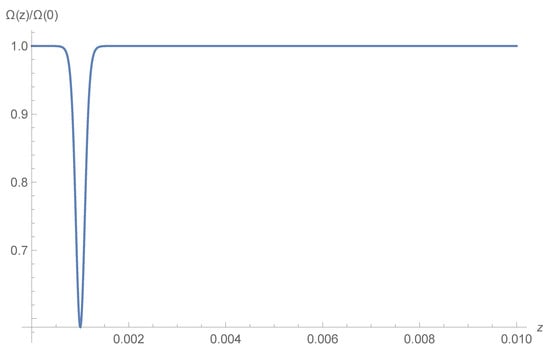
Figure 1.
The function is plotted as function of redshift. The gravitational coupling is varying only in a small range of redshift, without any effect on higher redshift observations.
The low redshift estimation of the Hubble parameter [1] , is based on a linear fit of the distance redshift relationship, i.e.,
Note that this definition corresponds to the actual method to estimate from low redshift SNe distance, and in general can be different from , which is the quantity considered in other studies of the effects of modified gravity [21]. In Figure 1 and Figure 2 we show the plot of the function and of for the model corresponding to , and . Inside the shell the value of of the shell model is modified w.r.t. , but at higher redshift the effect is asymptotically negligible, as shown in Figure 3 and Figure 4, so the rest of the cosmological parameters are expected not to be significantly affected by this kind of evolution.
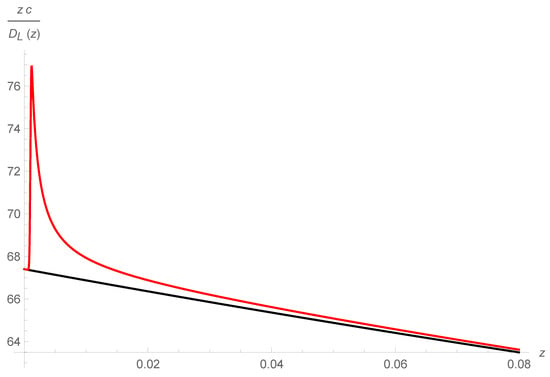
Figure 2.
The inverse slope of the luminosity distance is plotted as as function of redshift for a model (black) and and shell model (red), in units of . At low redshift this is giving the value the Hubble parameter estimated using luminosity distance observations [1]. Inside the shell the value of of the shell model is modified w.r.t. the model, explaining the Hubble tension, but at higher redshift the effect is asymptotically negligible.
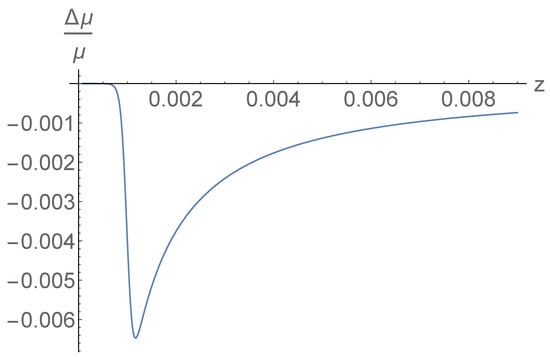
Figure 3.
The relative difference between the distance modulus of a shell model and a model is plotted as a function of redshift. The difference is asymptotically negligible, so only objects inside the shell are affected, i.e., anchors such as Cepheids and the megamaser.
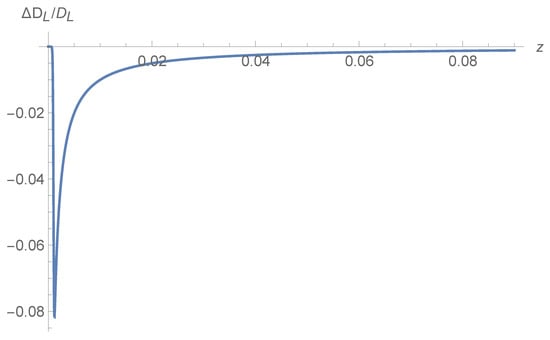
Figure 4.
The relative difference between the luminosity distance of a shell model and a model is plotted as a function of redshift. The difference is asymptotically negligible, so only objects inside the shell are affected, i.e., anchors such as Cepheids and the megamaser.
7. Effect on SNe Calibration
The variation of the gravity coupling at very low redshift is affecting the distance redshift relation of the anchors used to calibrate SNe, while their distance is not directly affected, because at higher redshift the distance is the same as in the CDM mode, as shown in Figure 4. This effect on calibration is propagating on the SNe distance estimation, and consequently on the estimation of . For a given observed apparent magnitude there is a degeneracy between the absolute luminosity M and , i.e., the same data is compatible with different sets of related by [22]
where the subscripts denote the values of different set of parameters.
This degeneracy is broken by including different observational data sets, such as CMB or calibrating SNe with independent distance anchors. The Hubble tension is related to the difference between the values of obtained in joint analysis with cosmic microwave background (CMB) data or with low redshift anchors. The value of the parameters corresponding to these different estimations of are reported in Table 1.

Table 1.
Values of obtained with different datasets. The first row shows the values from [1], and the second row the value of from [2] and the implied value of M obtained using Equation (36). The values obtained in previous observational data analysis are underlined, while the value of M for Planck, is inferred using Equation (36), and is not underlined.
8. Test with SNe Data
The CDM model is introducing a low redshift modification of the distance redshift relation which could potentially be incompatible with SNe observations. Nevertheless, due to the fact there are no SNe in that redshift range, it is expected that it should not affect significantly the goodness of fit, since the effects on the luminosity distance at higher redshift are negligible, as shown in Figure 4.
For this purpose we test the model with the Pantheon dataset [23], computing the according to
In the above equation C is the covariance matrix, and are the observed apparent magnitude and redshift, and is the theoretical apparent magnitude. The local value of is fitted with this expression for the
We show the comparison between different models in Table 2. We fix the cosmological parameters to the values obtained by analyzing the Planck mission data [2], except for the value of , which we vary to compare different models. We leave to a future work the full analysis of different cosmological observations, but as discussed in the next section, higher redshift observations are expected to be negligibly affected by the low redshift variation of , so that the check of the compatibility of data is the most important one. The results of the SNe data analysis are shown in Figure 5 and Figure 6.

Table 2.
The for different models is reported for SNe and , with and defined respectively in Equations (37) and (38). We define and denote with the reduced . The value of is obtained evaluating Equation (35) at = 0.001, corresponding to the anchors used to calibrate SNe. Note that CDM models with different sets of , given in Table 1, have the same because of the degeneracy given in Equation (36). The difference of the total between the first and second row is a manifestation of the Hubble tension, while the third row shows that a CDM can fit well the value of obtained in [1] with a value of compatible with CMB observations [2], resolving the tension.
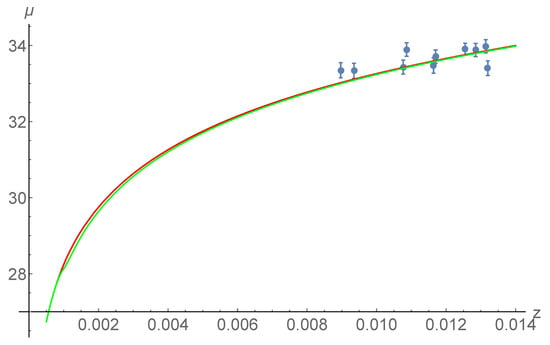
Figure 5.
The low redshift SNe [23] distance modulus is compared with different theoretical models. The red line corresponds to the CDM and the green to the CDM model, both with Planck parameters corresponding to the second row of Table 1. The two models give very similar predictions for , so that the only objects affected by the variation of the gravity coupling are those located at , i.e., the anchors, in agreement with Figure 4. The observational data points and their errors are plotted in blue.
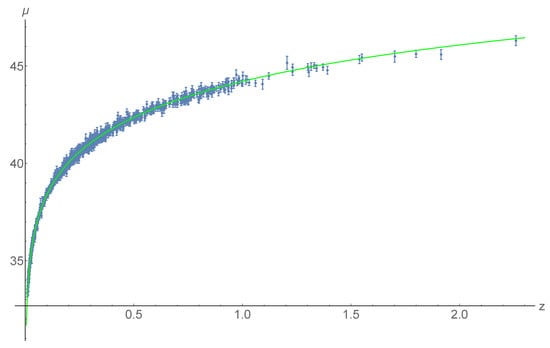
Figure 6.
The SNe [23] distance modulus is compared with different theoretical models. The red line corresponds to the CDM and the green to the CDM model, both with Planck [2] cosmological parameters corresponding to the second row of Table 1. The two models give very similar predictions for all SNe, and the two lines are undistinguishable at the scale of this plot. The only objects affected by the variation of the gravity coupling are those located at , i.e., the anchors, in agreement with Figure 4. See Figure 5 for a low redshift plot, where the two curves are distinguishable. The observational data points and their errors are plotted in blue.
9. Compatibility with Other Observations
The variation of the gravity coupling we have studied is affecting a narrow low redshift range, as shown in Figure 1 and Figure 4, so that early Universe observations such as Big Bang Nucleosynthesis (BBN) and Cosmic Microwave Background (CMB) are not affected by it.
In fact at high redshift , so that the modified Friedman equation reduces to the CDM Friedman equation. Since at high redshift the luminosity distance is the same of a CDM model, as shown in Figure 4, the distance to the last scattering surface is not affected by the low redshift variation of , and the fit of CMB data should be very closed to that of a CDM model with the same cosmological parameters. In regard to BBN, in the early Universe , so that the late time variation of has no effect on the early Universe formation of nuclei.
Other studies [20] have shown that a variation of the effective gravitational constant can alleviate the growth tension, and in the future it will be important to investigate the effects of a local variation of on cosmological perturbations, in particular on the matter power spectrum, but due to its narrow redshift range these effects are not expected to be very important.
10. Large Scale Structure Constraints on the Effective Gravitational Coupling
The function is related to the effective gravitational constant measured by large scale structure (LSS), and can be computed using the EFT of dark energy. These observations can hence provide important independent constraints on , to check if the parameters solving the Hubble tension are compatible with LSS.
The modification of gravity induces a modification of the Poisson’s equations [24]
with the effective gravitational constant given by [24]
The theories defined in Equation (1) correspond to , giving
where
The quantities and can be constrained by LSS and lensing observations respectively [25], but the parameterizations adopted therein are designed to study deviations from general relativity on cosmological scales, and are hence quite different from the local narrow variation in Equation (34). It is hence difficult to compare those constraints to the values of the parameters which can solve the Hubble tension using the parametrization in Equation (34), and a new analysis is required. Since the variation of is actively investigated, it is still important to study its effects on the luminosity distance, and hence on , even if these effects may not be large enough to solve the Hubble tension, because of LSS constraints on .
For the purpose of testing the compatibility of LSS data with a local variation of the type we have shown to be able to solve the Hubble tension, a redshift bins analysis of LSS and lensing observations would be required, with particular attention to data around , and we leave this to a future work. The scope of this paper is indeed to investigate the effects of the variation of the gravitational coupling on the luminosity distance, and determine what form of would be necessary to solve the Hubble tension, while at the same time fitting well SNe and other background observations such as the distance to the last scattering surface measured by the CMB, which is unaffected, as shown in Figure 4.
11. Implications for the Apparent Hubble Tension
The effect of the shell is to change w.r.t. , while asymptotically the luminosity distance is unaffected, and consequently high redshift observations such as the CMB will give a value of the Hubble parameter equal to . In a CDM model at low redshift , and the well known tension arises. A small time variation of explains naturally the apparent Hubble tension within the framework of the CDM model. Ignoring the redshift dependence of and fitting observational data with the model can lead to the apparent discrepancy between low and high redshift estimations of .
Note that the local estimation of is crucially dependent on geometrical distance anchors [26], such as the megamaser NGC 4258, which are located at a redshift . This implies that the Hubble tension can be resolved by a CDM model with parameters values such that the shell includes the anchors, i.e., for example .
12. Conclusions
We have shown that the time variation of the gravity coupling can provide a natural explanation to the apparent tension between the values of cosmological parameters estimated from observations corresponding to different epochs of the Universe history. We have given an example of a shell model, with strong variation of the matter-gravity coupling in a very narrow redshift range centered at , which can explain the difference between the local estimation of based on luminosity distance observations, and high redshift estimations, due to the effects on the SNe distance anchors. Since the variation of the gravity coupling is assumed to occur only at very low redshift, high redshift observations such as BBN and CMB are not affected by it. The model can fit well SNe data, since they are located at higher redshift, so that the variation of has an appeciable effect only on the distance anchors used to calibrate SNe, and consequently on the value of . While the local variation of is expected to have only negligible effects on high redshift observations, the full analysis of all available observational data sets is important to confirm the results obtained in this paper analyzing SNe data. We leave this task to a future upcoming work.
While in this paper we have focused on the effects on the background evolution, in order to estimate the effects on other cosmological observables, it will also be necessary to compute the effects on the evolution of cosmological perturbations, and to investigate its effects on the growth tension [20]. In this paper, inspired by the EFT, we have adopted a phenomenological approach in modeling the observational effects of , but in the future it will be important to investigate the fundamental origin of its variation, considering specific modified gravity theories.
Funding
This work was supported by the UDEA project 2023-63330.
Data Availability Statement
The SNe data analyzed in this paper are publicly available at https://github.com/dscolnic/Pantheon (accessed on 15 July 2024).
Acknowledgments
I thank the Osaka University Theoretical Astrophysics Group and the Yukawa Institute for Theoretical physics for their kind hospitality. I thank Theodore Tomaras and for interesting discussions about the difference between theories with a cosmological constant in Einstein or Jordan frame, and Mairi Sakellariadou for the suggestion to compare to observational data.
Conflicts of Interest
The authors declare no conflicts of interest. The funders had no role in the design of the study; in the collection, analyses, or interpretation of data; in the writing of the manuscript; or in the decision to publish the results.
Appendix A. Einstein Frame Cosmological Constant Model
Alternatively we could also consider the case of an Einstein frame cosmological constant given by
which corresponds to the special case of Equation (2) in which . In this case the non minimal coupling only affects the matter part of the energy-momentum tensor, not the dark energy part, since the cosmological constant term is the same as in general relativity, and the modified Friedman equation takes the form
Note that the dark energy term in Equation (A2) apparently differs from the limit of Equation (29), but the two equations are actually consistent. Accounting for the metric determinant transformation under a conformal transformation , the Einstein frame cosmological constant Lagrangian corresponds to c ), i.e., is not a constant, so that Equation (25) gives
which in the limit gives , due to the cancellation of the factors. This is consistent with Equation (A2) and is expected from the fact that the cosmological constant part of the Lagrangian in Equation (A1) is the same as in general relativity.
At low redshift the effects of the cosmological constant are negligible, so that observationally it may not be possible to distinguish between Equations (32) and (A2), but at at higher redshift the difference can become important. We leave to a future work the comparison with data to determine which dark energy model is in better agreement with high redshift observational data.
References
- Riess, A.G.; Yuan, W.; Macri, L.M.; Scolnic, D.; Brout, D.; Casertano, S.; Jones, D.O.; Murakami, Y.; An, G.S.; Breuval, L.; et al. A Comprehensive Measurement of the Local Value of the Hubble Constant with 1 km s−1 Mpc−1 Uncertainty from the Hubble Space Telescope and the SH0ES Team. Astrophys. J. Lett. 2022, 934, L7. [Google Scholar] [CrossRef]
- Aghanim, N. et al. [Planck Collaboration] Planck 2018 results. Astron. Astrophys. 2020, 641, A6. [Google Scholar] [CrossRef]
- Freedman, W.L.; Madore, B.F.; Hoyt, T.J.; Jang, I.S.; Lee, A.J.; Owens, K.A. Status Report on the Chicago-Carnegie Hubble Program (CCHP): Measurement of the Hubble Constant Using the Hubble and James Webb Space Telescopes. Astrophys. J. 2025, 985, 203. [Google Scholar] [CrossRef]
- Jiang, J.Q.; Liu, W.; Zhan, H.; Hu, B. Explanation of high redshift luminous galaxies from JWST by an early dark energy model. Phys. Rev. D 2025, 111, 023519. [Google Scholar] [CrossRef]
- Liu, W.; Zhan, H.; Gong, Y.; Wang, X. Can early dark energy be probed by the high-redshift galaxy abundance? Mon. Not. Roy. Astron. Soc. 2024, 533, 860–871. [Google Scholar] [CrossRef]
- Romano, A.E. Hubble trouble or Hubble bubble? Int. J. Mod. Phys. D 2018, 27, 1850102. [Google Scholar] [CrossRef]
- Aluri, P.K.; Cea, P.; Chingangbam, P.; Chu, M.C.; Clowes, R.G.; Hutsemékers, D.; Kochappan, J.P.; Lopez, A.M.; Liu, L.; Martens, N.C.; et al. Is the observable Universe consistent with the cosmological principle? Class. Quant. Grav. 2023, 40, 094001. [Google Scholar] [CrossRef]
- Di Valentino, E.; Mena, O.; Pan, S.; Visinelli, L.; Yang, W.; Melchiorri, A.; Mota, D.F.; Riess, A.G.; Silk, J. In the realm of the Hubble tension—A review of solutions. Class. Quant. Grav. 2021, 38, 153001. [Google Scholar] [CrossRef]
- Montani, G.; DeAngelis, M.; Bombacigno, F.; Carlevaro, N. Metric f(R) gravity with dynamical dark energy as a scenario for the Hubble tension. Mon. Not. Roy. Astron. Soc. 2023, 527, L156–L161. [Google Scholar] [CrossRef]
- Gleyzes, J.; Langlois, D.; Piazza, F.; Vernizzi, F. Essential building blocks of dark energy. J. Cosmol. Astropart. Phys. 2013, 8, 25. [Google Scholar] [CrossRef]
- Côté, J.; Faraoni, V.; Giusti, A. Revisiting the conformal invariance of Maxwell’s equations in curved spacetime. Gen. Rel. Grav. 2019, 51, 117. [Google Scholar] [CrossRef]
- D’Inverno, R. Introducing Einstein’s Relativity; Clarendon Press: Oxford, UK, 1992. [Google Scholar]
- Dabrowski, M.P.; Garecki, J.; Blaschke, D.B. Conformal transformations and conformal invariance in gravitation. Annalen Phys. 2009, 18, 13–32. [Google Scholar] [CrossRef]
- Uzan, J.-P.; Pernot-Borràs, M.; Bergé, J. Effects of a scalar fifth force on the dynamics of a charged particle as a new experimental design to test chameleon theories. Phys. Rev. D 2020, 102, 044059. [Google Scholar] [CrossRef]
- Romano, A.E.; Sakellariadou, M. Mirage of Luminal Modified Gravitational-Wave Propagation. Phys. Rev. Lett. 2023, 130, 231401. [Google Scholar] [CrossRef] [PubMed]
- Chiba, T.; Yamaguchi, M. Conformal-frame (in)dependence of cosmological observations in scalar-tensor theory. J. Cosmol. Astropart. Phys. 2013, 10, 40. [Google Scholar] [CrossRef]
- Deruelle, N.; Sasaki, M. Conformal Equivalence in Classical Gravity: The Example of “Veiled” General Relativity. In Cosmology, Quantum Vacuum and Zeta Functions; Springer Proceedings in Physics; Springer: Berlin/Heidelberg, Germany, 2011; Volume 137, pp. 247–260. [Google Scholar] [CrossRef]
- Rondeau, F.; Li, B. Equivalence of cosmological observables in conformally related scalar tensor theories. Phys. Rev. D 2017, 96, 124009. [Google Scholar] [CrossRef]
- Paraskevas, E.A.; Perivolaropoulos, L. Effects of a Late Gravitational Transition on Gravitational Waves and Anticipated Constraints. Universe 2023, 9, 317. [Google Scholar] [CrossRef]
- Marra, V.; Perivolaropoulos, L. Rapid transition of Geff at zt ≃ 0.01 as a possible solution of the Hubble and growth tensions. Phys. Rev. D 2021, 104, L021303. [Google Scholar] [CrossRef]
- Schiavone, T.; Montani, G.; Bombacigno, F. f(R) gravity in the Jordan frame as a paradigm for the Hubble tension. Mon. Not. Roy. Astron. Soc. 2023, 522, L72–L77. [Google Scholar] [CrossRef]
- Mazo, B.Y.D.V.; Romano, A.E.; Quintero, M.A.C. H0 tension or M overestimation? Eur. Phys. J. C 2022, 82, 610. [Google Scholar] [CrossRef]
- Scolnic, D.M.; Jones, D.O.; Rest, A.; Pan, Y.C.; Chornock, R.; Foley, R.J.; Huber, M.E.; Kessler, R.; Narayan, G.; Riess, A.G.; et al. The Complete Light-curve Sample of Spectroscopically Confirmed SNe Ia from Pan-STARRS1 and Cosmological Constraints from the Combined Pantheon Sample. Astrophys. J. 2018, 859, 101. [Google Scholar] [CrossRef]
- Linder, E.V.; Sengör, G.; Watson, S. Is the Effective Field Theory of Dark Energy Effective? J. Cosmol. Astropart. Phys. 2016, 5, 53. [Google Scholar] [CrossRef]
- Ishak, M.; Pan, J.; Calderon, R.; Lodha, K.; Valogiannis, G.; Aviles, A.; Niz, G.; Yi, L.; Zheng, C.; Garcia-Quintero, C.; et al. Modified Gravity Constraints from the Full Shape Modeling of Clustering Measurements from DESI 2024. arXiv 2024, arXiv:2411.12026. [Google Scholar] [CrossRef]
- Efstathiou, G. To H0 or not to H0? Mon. Not. Roy. Astron. Soc. 2021, 505, 3866–3872. [Google Scholar] [CrossRef]
Disclaimer/Publisher’s Note: The statements, opinions and data contained in all publications are solely those of the individual author(s) and contributor(s) and not of MDPI and/or the editor(s). MDPI and/or the editor(s) disclaim responsibility for any injury to people or property resulting from any ideas, methods, instructions or products referred to in the content. |
© 2025 by the author. Licensee MDPI, Basel, Switzerland. This article is an open access article distributed under the terms and conditions of the Creative Commons Attribution (CC BY) license (https://creativecommons.org/licenses/by/4.0/).